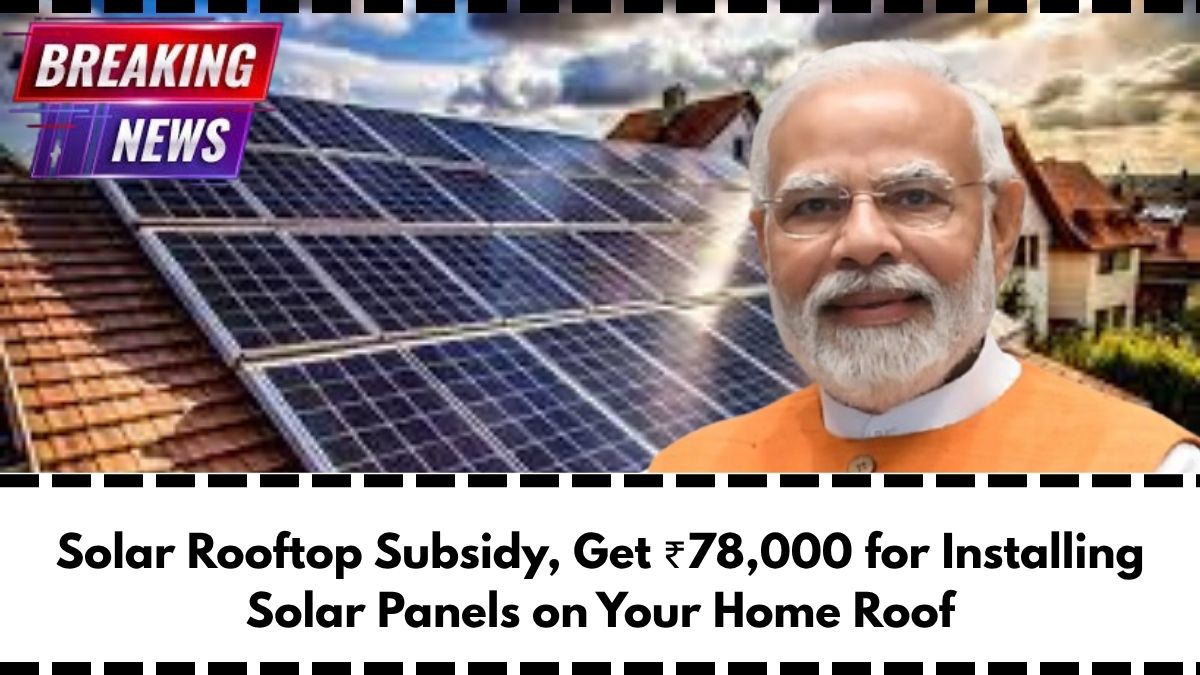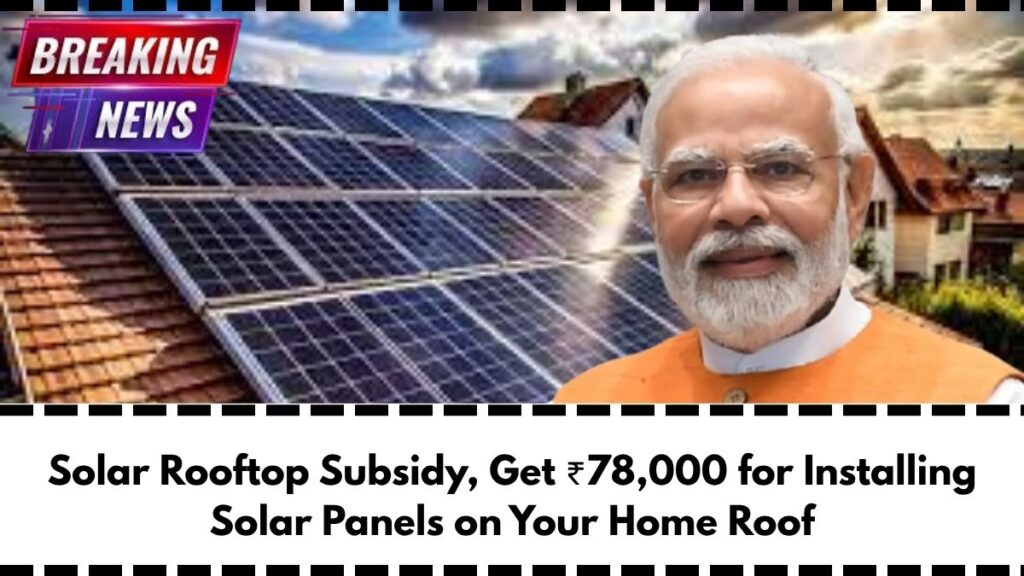The Solar Rooftop Subsidy Scheme introduced by the Government of India is a strategic step toward achieving sustainable energy goals, reducing dependence on fossil fuels, and lowering the burden of electricity bills on Indian households. The scheme offers financial subsidies of up to ₹78,000 for homeowners who install rooftop solar panels. This initiative not only helps in reducing carbon emissions but also enables long-term economic savings and power independence for families across both urban and rural India.

Summary Table
Feature |
Details |
|---|---|
Scheme Name |
Solar Rooftop Subsidy Scheme |
Launch Authority |
Government of India |
Maximum Subsidy |
₹78,000 for 3 kW systems (40% subsidy) |
Eligibility |
All Indian residents with suitable rooftop space |
Application Mode |
Online via National Solar Portal |
Net Metering |
Yes, allows sale of excess electricity |
Average Payback Period |
4–6 years |
Long-Term Savings |
₹2,500 to ₹12,000/month depending on capacity |
Environmental Benefit |
Up to 4 tons of CO₂ reduction per year (3 kW system) |
Official Website |
Understanding the Solar Rooftop Subsidy Scheme
This centrally sponsored scheme aims to promote solar energy usage by making rooftop solar systems affordable for average Indian households. Through subsidies and technical support, the government encourages the use of renewable energy sources over conventional electricity.
Key Objectives
-
Energy Independence: Reduce dependence on the grid and fossil fuels.
-
Affordability: Lower electricity bills through energy generation.
-
Environmental Conservation: Support India’s carbon reduction goals.
-
Rural Inclusion: Extend benefits to power-deficient rural areas.
-
Employment Generation: Boost solar industry-related jobs and training.
Subsidy Structure and Financial Benefits
The scheme follows a tiered subsidy structure based on system size. Here’s a detailed breakdown:
For Systems Up to 3 kW
-
Subsidy: 40%
-
Max Amount: ₹78,000
-
Estimated Cost Post Subsidy: ₹1.17 lakh (from ₹1.95 lakh)
-
Payback Period: 4–5 years
For Systems Between 3 kW to 10 kW
-
Subsidy: 40% for the first 3 kW, 20% for remaining capacity
-
Total Savings: Substantial reduction in cost and long-term electricity bills
-
Payback Period: 5–6 years
For Systems Above 10 kW
-
Subsidy: Not applicable under central scheme
-
Support: May qualify for state-level incentives or tax benefits
-
Payback Period: 6–8 years (commercial rates apply)
Monthly Savings and Net Metering
Approximate Savings Per System Size
Capacity |
Monthly Generation |
Estimated Savings |
|---|---|---|
3 kW |
360–450 units |
₹2,500–₹3,500 |
5 kW |
600–750 units |
₹4,000–₹5,500 |
10 kW |
1,200–1,500 units |
₹8,000–₹12,000 |
Net Metering Benefits
-
Allows homeowners to sell excess electricity back to the grid.
-
Generates additional income or credit against future bills.
-
Enhances return on investment by reducing bill to zero in some cases.
Environmental and Social Impact
Environmental Advantages
-
CO₂ Reduction: A 3 kW system can reduce up to 4 tons annually.
-
Cleaner Air: Less dependency on coal-fired power generation.
-
Energy Conservation: Reduced pressure on national energy resources.
Social Benefits
-
Electrification: Brings power to remote regions.
-
Job Creation: Boosts employment in installation and maintenance.
-
Skill Development: Trains youth in solar technology.
-
Community Upliftment: Improves quality of life through reliable electricity.
Eligibility Criteria
To qualify for the scheme, homeowners must meet certain requirements:
Technical Requirements
-
Minimum 10 sq. meters of shadow-free roof space
-
Structurally stable rooftop (load of 15–20 kg/m²)
-
Existing electricity meter and grid connection
-
Minimum age of 18 years
Required Documents
-
Identity proof: Aadhaar, PAN, Voter ID
-
Address proof: Property documents, electricity bill
-
Financials: Bank passbook, income certificate
-
Technical: Roof photos, structural report
-
Others: Passport-size photos
Application Process: Step-by-Step
-
Registration:
-
Visit https://solarrooftop.gov.in and create an account.
-
-
Document Upload:
-
Submit scanned copies of required documents online.
-
-
Site Assessment:
-
Approved vendors will conduct a survey for feasibility.
-
-
Approval:
-
Application is reviewed and approved by local DISCOM.
-
-
Installation:
-
Certified installer installs the system as per guidelines.
-
-
Inspection & Commissioning:
-
Final verification by government team before activation.
-
-
Subsidy Disbursement:
-
Subsidy is transferred directly to applicant’s bank account.
-
State-Level Benefits
Many states supplement the central subsidy with local incentives:
-
Property Tax Exemptions for homes with rooftop systems.
-
Faster Permit Approvals to encourage wider adoption.
-
Additional Subsidies or Rebates on system components.
-
Community Discounts for group solar installations.
Technology and Future Prospects
To enhance efficiency and user convenience, the scheme integrates modern technology:
-
Smart Monitoring: Apps provide real-time tracking of output and usage.
-
Smart Meters & Inverters: Seamless grid integration and performance tracking.
-
Maintenance Packages: Service and warranty options offered by vendors.
-
Battery Storage: Optional backups for uninterrupted power supply.
Addressing Challenges
Despite its benefits, the scheme faces certain obstacles:
Common Issues
-
High upfront cost even after subsidy.
-
Limited awareness in rural regions.
-
Technical complexity and misinformation.
-
Grid connectivity gaps in remote areas.
Government Solutions
-
Low-Interest Loans: Partnered with banks for easy EMI plans.
-
Awareness Drives: Educating citizens via campaigns and seminars.
-
Vendor Certification: Ensuring only approved installers are used.
-
Infrastructure Upgrades: Strengthening rural grid networks.
For more details and to apply, visit the official portal:
https://solarrooftop.gov.in
FAQs
Q1: What is the maximum subsidy amount under the scheme?
A: ₹78,000 for a 3 kW solar rooftop system, representing a 40% subsidy.
Q2: What is the usual payback period for a solar installation?
A: Between 4 to 6 years, depending on usage and system size.
Q3: Can I earn money from solar energy?
A: Yes, through net metering, excess energy can be sold to the grid for credits or payments.
Q4: Do solar panels work during monsoons or cloudy days?
A: Yes, though with reduced output. Grid or battery backup ensures uninterrupted supply.
Q5: Are subsidies uniform across all states?
A: Central subsidies apply nationwide, but individual states may offer extra incentives.
Conclusion: A Bright Future for Indian Homes
The Solar Rooftop Subsidy Scheme is more than a financial aid initiative—it is a transformative mission that aligns individual savings with national sustainability goals. With rising electricity tariffs and growing climate change concerns, this scheme presents a timely opportunity for homeowners to adopt clean energy solutions.
The long-term economic, social, and environmental benefits make it a win-win for everyone. By choosing rooftop solar now, citizens contribute to a cleaner planet, lower their monthly expenses, and strengthen India’s energy independence for future generations.
For More Information Click Here






